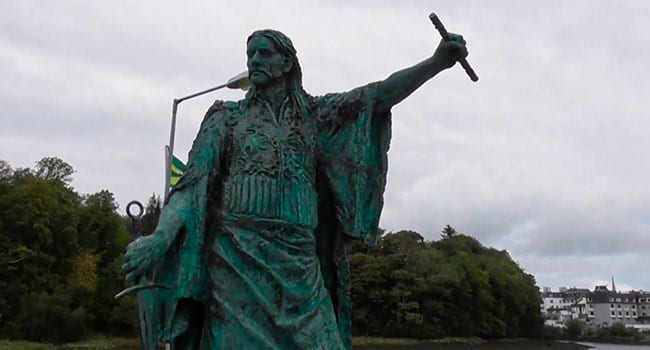 The Spanish city of Valladolid has an Irish historical connection. It was there that Red Hugh O’Donnell was buried in 1602.
The Spanish city of Valladolid has an Irish historical connection. It was there that Red Hugh O’Donnell was buried in 1602.
Now, thanks to an archaeological dig aimed at finding his long-lost tomb, the connection is back in the news.
Known as Red Hugh because of his hair colour, he was the kind of historical figure who often fires imaginations. He was brave to the point of recklessness and died young.
And to augment the sense of tragedy, his death occurred far from home while on a futile mission seeking Spanish military assistance against the English and their local allies in Ireland.
As a child, I had a particular affinity for Red Hugh.
Part of this was down to reading The Flight of the Eagle, the heroic novelization of his youthful imprisonment and dramatic escape. Schoolboys invariably love that sort of stuff.
There was also the matter of a distant connection on my mother’s side. Her family came from what had been O’Donnell territory and had functioned as keepers of the sacred relic that was used to inspire the army as it headed into battle. That made them players in Red Hugh’s world.
The O’Donnells became dominant in the Irish northwest from the 13th century. To quote one historian, they “ran it almost as a family enterprise.”
And they were politically shrewd, cultivating relationships with the Stuart kings of Scotland and the Tudors of England.
Although ostensibly loyal subjects of the English Crown, the O’Donnells operated with a huge degree of independence. So having the Tudors as overlords wasn’t necessarily a burden. After all, almost everybody had an overlord and a detached, distant sovereign was better than one who lived next door.
Then the Crown began to change the rules.
It started in the 1570s, driven by the centralizing tendencies of the early modern state and the political dynamics of Reformation Europe.
In an environment where sectarian persecution was practised by all sides, religious affinity became a litmus test of loyalty. And like other Irish Gaelic lordships, the O’Donnells were Catholic while the Tudors were Protestant.
Accordingly, the Tudor administration began to meddle, which included kidnapping the teenage Red Hugh for hostage purposes in 1587. Four years of imprisonment left him an understandably resentful man.
After replacing his father as O’Donnell chieftain, Red Hugh was instrumental in launching the protracted Gaelic rebellion known as the Nine Years War. The older and wilier Hugh O’Neill may have been the senior partner in that endeavour but Red Hugh was the prime mover in the revolt’s boldest gambit – the Spanish alliance.
Pursuing the alliance as early as 1592, Red Hugh had a straightforward proposition. He was going to swap sovereigns. Instead of being a vassal of Elizabeth of England, he was going to be a vassal of Philip of Spain.
In return for accepting Philip as sovereign, he expected two things. One was the military and financial assistance necessary to defeat Elizabeth. The other was that Philip would recognize the O’Donnells’ sphere of interest and prerogatives.
And there was, of course, the religious aspect. Philip’s Spain was fiercely Catholic, so the O’Donnells would be back on the politically smart side of the religious divide.
If the gambit had worked, Ireland would’ve technically become a Spanish possession, albeit a possession where day-to-day authority was probably exercised by families like the O’Donnells.
And there would’ve been no early 17th century Protestant settlement in the north of Ireland, thereby precluding the historical roots of the region’s persistent sectarian conflicts.
Mind you, Ireland would also have become the de facto frontline in the multi-century hostilities between Spain and England. There might have been a price to pay for that, perhaps even a severe one.
In any event, the gambit failed.
Although a significant Spanish force did arrive, it landed at the wrong end of the country and the ensuing debacle worked out badly for the rebels. Consequently, Red Hugh headed to Spain to seek another force.
Philip initially agreed but then changed his mind and Red Hugh died before he had a chance to appeal.
With pomp and ceremony, he was buried in the Franciscan monastery in Valladolid. However, the tomb’s precise location was lost after the monastery’s 19th century destruction.
As of this writing, the current dig has uncovered skeletal remains. Whether any belong to Red Hugh is still to be determined.
Troy Media columnist Pat Murphy casts a history buff’s eye at the goings-on in our world. Never cynical – well, perhaps just a little bit.
The views, opinions and positions expressed by columnists and contributors are the author’s alone. They do not inherently or expressly reflect the views, opinions and/or positions of our publication.


